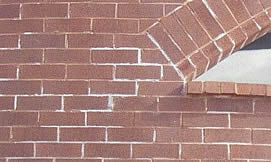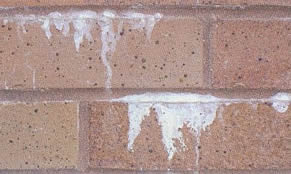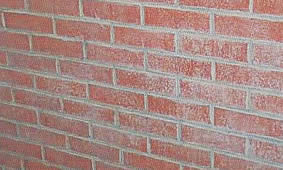For centuries brick has been used to create durable, beautiful structures. At times, however, the appearance of the brick is negatively affected by efflorescence or stains. These may be caused by a variety of sources, and identifying the source is important for effective removal and future prevention.
Efflorescence
Technically speaking, efflorescence is not a stain. However for the sake of identification purposes, we will discuss it here. Efflorescence is a harmless deposit of water soluble, white salt crystals. Sometimes it appears on the brick itself, and sometimes it appears on the mortar joints. It may appear in limited areas or cover the entire surface of the masonry on a building. It is usually white in color, but not all white stains are necessarily efflorescence. Lime run is occasionally mistaken for efflorescence.
Efflorescence on brick surface Efflorescence in mortar joints
 
Lime Run (Carbonate Deposits)
The term "lime run" can be misleading since the stain is not a direct result of the lime component in the mortar. In fact, hydrated lime may help to reduce the risk of lime run. The term "lime run" actually refers to calcium carbonate deposits which appear as white or gray crusty formations running down the face of the brick. It can be traced to the calcium compounds found in trim, mortar, or other construction materials. Lime run nearly always occurs at a small hole or along a hairline crack in the face of the brick. Lime run requires large quantities of water that follow the same path over an extended period of time, similar to the formation of stalactites in limestone caves. The water takes the calcium compounds to the surface of the brick where it reacts to the carbon dioxide in the air. To reduce the possiblility of lime run, excess water must be elimated or the path disrupted. Once lime run begins, it is likely to continue until the water source is stopped.
Lime run on brick wall Close-up of lime run
 
Stains from External Sources
Other stains affecting brickwork are generally caused by external sources such as pollution, organic growth, or runnoff. Certain materials above or adjacent to brick such as copper, bronze, stucco, paint, or hard water from sprinkler systems can affect brickwork. Organic stains may include algae, mold, or other organisms. Rust-colored stains may actually be corrosion and the result of wall ties or joint reinforcements placed without adequate cover.
Organic Stain Hard Water Stain
 
Summary and Solutions
The proper identification of efflorescence and stains on brickwork is essential to stain removal. Photographs and laboratory or field testing can assist in this effort. When uncertain of the composition or origin of stains, verification by an experienced brick/masonry professional is recommend. The use of an incorrect agent or method could result in further staining that is more difficult to remove than the original stain. Understanding the mechanisms involved with the formation of efflorescence and stains on brickwork is useful in design and construction to minimize their occurrence.
<< Back to Technical Library |